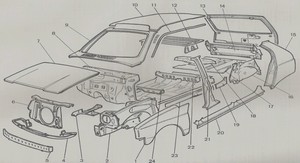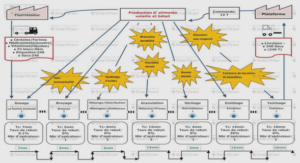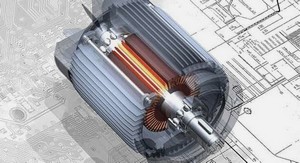Analytic Energy Consumption of Single-Source Vehicles
Conventional Vehicle FACE, standing for Fully-Analytic energy
Consumption Estimation, analytically approximates the energy consumption of a conventional vehicle with dimension-related parameters and cycle-related parameters. Dimension-related parameters consist of dimensioning parameters of powertrain components and vehicles. The dimensionrelated parameters are vehicle-dependent, such as engine displacement and vehicle mass. Cycle-related parameters are in function of mission variables, such as velocity and acceleration. For conventional vehicles, gear sequence is also a mission variable. For example, a cycle-related parameter can be v 2ant . Details of the dimension- and cycle-related parameters are found in the following section. Considering the evaluation of energy consumption, the dimension-related parameters are originated from the investigated conventional vehicle; whereas cycle-related parameters are determined a priori based on a reference vehicle. Moreover, cycle-related parameters are influenced by the status of the internal combustion engine. Specifically, an engine converts burned fuel to mechanical power in propulsion phase; whereas the engine does not consume any fuel during the braking condition. Moreover, the idling fuel consumption is assumed to omit due to the adoption of stop-start systems.
Fully Analytic Energy
Consumption Estimation Due to high performance of an internal combustion engine, the operating points over a standardized mission are often concentrated at low speed and low- and mid-load area in its efficiency map. Thus, only the first case of the light-duty engine piece-wise model is implemented in FACE. Combining analytic models of internal combustion engine in Eq. 2.2 (only first case), transmission in Eq. 2.24 and 2.25, and vehicle load model in Eq. 2.38, the power of burned fuel at time t is written by Pef = ke0 + ke1Cv0v kt5 + ke1Cv1v 2 + ke1Cv2v 3 + ke1va kt5 , (5.1) where Pef is valid only when vehicle load Fl > 0. Descriptive parameters in Eq. 5.1, such as ke0, ke1, and kt5, are substituted with their corresponding predictive models introduced in Chapter 2. Thus, dimensioning parameters constitute the dimension-related parameters, which depend on the investigated vehicle. Then, cycle-related parameters are separated in each term of the full expansion of Eq. 5.1. Because of the implementation of a reference vehicle, cycle-related parameters are constant in FACE. Consisting of dimension-related variables and cycle-related parameters, FACE for conventional vehicles is expressed as Eef = i=5,j X =1,k=8 i=1,j=0,k=0 DijkCijk, (5.2) where Dijk are dimension-related variables of the investigated vehicle, and Cijk are cyclerelated parameters of a reference vehicle, subscripts i, j,k correspond to the exponents of velocity, acceleration, and gear number. The dimension of the full expansion of Eq. 5.2 is so large that both dimension-and cycle-related parameters are simplified. Details of each dimension-related parameter are found in Appendix D.1. As for the cycle-related parameters based on a reference 5.1. Conventional Vehicle 99 vehicle, they are summarized by Cijk = X t∈σ v i (t)a j (t)n k t (t)∆t, (5.3) where the mission variables – including, velocity v, acceleration a, and gear shift schedule nt – the set of effective time steps σ, and the time interval ∆t are involved. The set of effective time steps σ is defined by σ = n t : Fl (t) > 0, t ∈ [t0, tf ] o , (5.4) where Fl is vehicle load estimated in Eq. 2.38, σ is the set of valid time steps based on the reference vehicle. Since not all of the combinations of i, j, and k exist in FACE, the valid combinations for conventional vehicles are summarized as i = 1, jk = {00,01,02,03,04,10}, i = 2, jk = {00,01,02,03,04,05,06,07,08,10,11,12,13,14}, i = 3, jk = {00,01,02,03,04,05,06,07,08,10,11,12,13,14,15,16,17,18}, (5.5) i = 4, jk = {00,01,02,03,04,05,06,07,08}, i = 5, jk = {00,01,02,03,04,05,06,07,08}.
Sensitivity of Dimensioning Parameters
Although FACE is developed, relations between energy consumption and powertrain dimensioning parameters are implicit in Eq. 5.2. To make FACE more intuitive, sensitivity of powertrain dimensioning parameters proffers explicit relations below. Concerning dimensioning parameters of internal combustion engines, the energy consumption is a linear function of engine displacement, which yields Eef (Ve ) = κe0 + κe1Ve , (5.6) where parameters κ(···) are generic and derived from Eq. 5.2. Expressions of parameters κ will not be fully expanded for simplicity reason. Regarding the dimensioning parameters of drivetrain, quadratic models are feasible to the gear ratios of first and last gear (Rt1 and Rtk) and the ratio of final drive (Rf d), 100 CHAPTER 5. Analytic Energy Consumption of Single-Source Vehicles which are given by Eef (Rt1) = κt0 + κt1Rt1 + κt2R2 t1 , (5.7) Eef (Rtk) = κt3 + κt4Rtk + κt2R2 tk, (5.8) Eef (Rf d) = κd0 + κd1Rf d + κd2R2 f d. (5.9) Note that, the overall gear ratios are considered for Rt1 and Rtk if the final drive is of multiple speeds. Meanwhile, the ratio Rf d is assumed to be one in this condition. In addition, energy consumption is also expressed as functions of vehicle parameters. Since parameter Cv0 is approximated by Cv0 ≈ mvgCrr, the relations between the energy consumption and vehicle parameters are separately presented as Eef (Cv2) = κv0 + κv1Cv2, (5.10) Eef (Cv1) = κv2 + κv3Cv1, (5.11) Eef (Cv0) = κv4 + κv5Cv0, (5.12) Eef (mv ) = κv6 + κv7mv . (5.13)
Battery-Electric Vehicle
To optimize the dimensioning parameters of powertrain components, FACE is also developed for battery-electric vehicles with single-speed transmissions. Similar to conventional vehicles, FACE estimates the energy consumption of a battery-electric vehicle with dimension- and cycle-related parameters. Dimension-related parameters associate with a battery-electric vehicle to investigate, including battery, electric motor/generator, and single-speed transmission; whereas cycle-related parameters are mission-dependent and reference-vehicle-dependent constants. In a battery-electric vehicle, battery is discharged as an energy source to propel the vehicle. Yet, it can also be charged to recuperate energy during braking. These operations segment the analytic model of battery electrochemical power into to conditions because of the efficiency of the drivetrain. The standstill operation is included in the propelling operation. 5.2. Battery-Electric Vehicle 1
Fully Analytic Energy
Consumption Estimation The consumed electrochemical power of battery is calculated in a piecewise function by combining analytic models of battery in Eq. 2.30 (the quadratic model), electric motor/generator in Eq. 2.35, and single-speed transmission in Eq. 2.22 and 2.25, and vehicle load model in Eq. 2.38. In the fully expanded electrochemical power of battery, the same items of mission variables are merged that account for the cycle-related parameters. The rest terms, consisting of powertrain dimensioning parameters and constants, make up the dimension-related parameters. Because of its too large dimension, the expression of FACE for battery-electric vehicles is simplified as Ebe = X 2 β=1 i=8 X ,j=4 i=0,j=0 D bβ ij C β ij, (β = 1,2), (5.14) where β refers traction (β = 1) and braking operation (β = 2); D bβ ij are dimension-related parameters in accordance with vehicle operating conditions; and C β ij are cycle-related parameters based on a reference vehicle. The detailed dimension-related parameters are listed in Appendix D.2; whereas the cycle-related parameters of a reference battery-electric vehicle are summarized as C β ij = X t∈σbβ v i (t)a j (t)∆t, (β = 1,2), (5.15) where σbβ are sets of time steps corresponding to vehicle operating conditions. The time sets σbβ(β = 1,2) in accordance with the operating conditions of a reference vehicle are summarized in an overall time set σbβ, which yields σbβ = σb1 = {t : Fl (t) ≥ 0} σb2 = {t : Fl (t) < 0} . (5.16) The existing combinations of i and j in Eq. 5.14 and 5.15 are summarized as i = {0,1,2,3,4,5,6,7,8}, j = 0, i = {0,1,2,3,4,5,6}, j = 1, i = {0,1,2,3,4}, j = 2, (5.17) i = {0,1,2}, j = 3, i = {0}, j = 4. Because of the implemented transmissions, the FACE in this section is dedicated to battery-electric vehicles of single-speed transmissions.
Sensitivity of Dimensioning
Parameters Explicit relations between energy consumption and powertrain dimensioning parameters (including vehicle parameters ) are formulated to make FACE intuitive and obvious. Concerning dimensioning parameters of battery, FACE is nonlinear as a function of battery cell number Kb and battery cell capacity Qb as expressed by Ebe(Kb ) = κb0 + κb1Kb + κb2 Kb , (5.18) Ebe(Qb ) = κb3 + κb4Qb + κb5Q 2 b . (5.19) Regarding to dimensioning parameters of electric motor/generators, FACE is a fourth degree polynomial as a function of rated torque Tm and of base speed Nm. The quartic polynomials are re-written by Ebe(Tm) = κm0 + κm1Tm + κm2T 2 m + κm3T 3 m + κm4T 4 m , (5.20) Ebe(Nm) = κm5 + κm6Nm + κm7N 2 m + κm8N 3 m + κm9N 4 m. (5.21) With regard to dimensioning parameters of a drivetrain, high nonlinearity of FACE exists, such as Ebe(Rt ) =X 4 i=0 κdiRi t + κd5 Rt + κd6 R2 t + κd7 R4 t , (5.22) Ebe(Rf d) =X 4 i=0 κdiRi f d + κd5 Rf d + κd6 R2 f d + κd7 R4 f d . (5.23) Relations between energy consumption and vehicle parameters are given by Ebe(Cv2) = κv0 + κv1Cv2 + κv2C 2 v2 + κv3C 3 v2 + κv4C 4 v2 , (5.24) Ebe(Cv1) = κv5 + κv6Cv1 + κv7C 2 v1 + κv8C 3 v1 + κv9C 4 v1 , (5.25) 5.3. Analytic Evaluation of Energy Consumption 103 Ebe(Cv0) = κv10 + κv11Cv0 + κv12C 2 v0 + κv13C 3 v0 + κv14C 4 v0 , (5.26) Ebe(mv ) = κv15 + κv16mv + κv17m 2 v + κv18m 3 v + κv19m 4 v . (5.27)
Analytic Evaluation of Energy
Consumption FACE is applied to approximate the energy consumption of several single-source vehicles. The energy consumption is compared based on the evaluation with different methods, such as of FACE and Quasi-Static Simulations (QSS). The predictive analytic models of powertrain components are applied to the evaluation of energy consumption through FACE. Instead, the grid-point data is used in the evaluation via QSS. As a result, errors of different types of powertrain data is introduced.
Conventional Vehicle
Conventional vehicles of different engine technologies but same drivetrain and vehicle are investigated through both FACE and QSS. Note that, the type of powertrain models in FACE is different from that in QSS. Reference Vehicles Main characteristics of the investigated conventional vehicles are summarized in Table 5.1. The reference vehicle (Vehicle I) and the investigated vehicles (Vehicle II, III, and IV) have the same vehicle parameters and drivetrain. The varied dimension-related variables are composed of engine displacement and the engine rated torque and power. In addition, Vehicle I is used to estimate the cycle-related parameters for the evaluation of fuel consumption of Vehicle II, III, and IV over various missions. Results and Analysis Comparisons of fuel consumption are illustrated in Fig. 5.1. The highest error between FACE and QSS is presented by Vehicle I over FTP-72, which is 3.85%. As for the least one, it is about 0.83% of Vehicle II over HYWFET. However, there are several sources of errors that could impact the comparisons. Firstly, models of powertrain components are different, which are grid-point data and predictive analytic model. Secondly, FACE is developed based on the first case of light-duty engine model in Eq. 2.2, which means engine power that is larger than the corner power (Pe > Pec) requires




